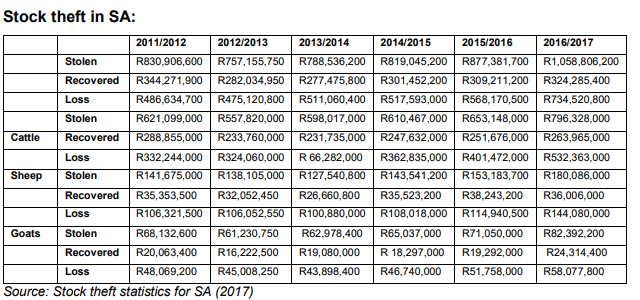
Stock theft figures for 2016/2017 indicate that the most sheep were stolen in the Eastern Cape, more than 40,000. The Free State is in the second place, more or less 20,000 and then the Northern Cape, nearly 7,500. The scenario for cattle differs, with KwaZulu-Natal showing the highest stock theft figure, more than 14,000, followed by the Free State, more than 10,000 and the North West, nearly 10,000.

The highest number of goats were stolen in KwaZulu-Natal in 2016/2017, more or less 13,000 with the Eastern Cape in the second place, more than 7,000; and Limpopo, more than 4,000 in the third place.
Looking at trends in the various provinces it is clear that cattle theft escalated in all the provinces during 2016/2017, with the exception of the Eastern Cape. According to SAPD statistics, sheep theft increased in the Eastern Cape, the North West and Gauteng while it decreased in the Western Cape, the Northern Cape, Free State and Mpumalanga. It remained fairly constant in Limpopo and KwaZulu-Natal.

The recovery rate indicates that the tempo of recovering cattle has worsened between 2011/2012 and 2016/2017. The recovery rate of sheep showed more variation during the time period but decreased by 5% between 2015/2016 and 2016/2017. The recovery rate of goats remained fairly constant at between 26% and 30% during the time period.
Statistics also indicate that the number of cases reported declined while the average amount of stock stolen during any reported incident, is steadily increasing. There may be two possible explanations for this. It may be that livestock farmers don’t deem it necessary to report smaller losses (one or two sheep) to the SAPD, only reporting the bigger incidents. It can also be an indication that stock theft syndicates steal less often, but more livestock is taken per incident. They are also more successful in getting rid of the livestock before it can be recovered.
Official figures from the SAPS cannot be the only statistics taken into account. Statistics SA found that the rate of stock theft cases not reported, worsened from 67.7% in 2015 to 70.1% in 2016. In other words, more than 70% of stock theft cases are not reported to the SAPD. A study in the Free State, Eastern Cape and KwaZulu-Natal, undertaken by the University of the Free State, revealed that the recovery rate of stolen livestock is much lower than indicated by SAPS statistics. According to the study, more livestock was lost in all provinces than indicated by SAPS. The recovery rate is also lower than the official figures. The greatest losses have been reported in the Free State, where almost 85,000 sheep or 1.82% of sheep are annually lost. Direct cost alone, of stock theft in the three provinces, is calculated at about R477m per year and a further R166m is spent by producers on combating stock theft.
Researchers found that unemployment and the drought are the main causes of stock theft. South Africa already has one of the highest unemployment rates in the world and we are not able to come up with appropriate solutions. The country is also in the grip of an ongoing drought. These factors also played a role in the increase in livestock losses during 2016/2017.
According to a recent study on the drought by the RPO, it is estimated that the national cattle herd has decreased with around 15% and the sheep herd with around 14%. During December 2017, 30% less livestock was slaughtered compared to the same period the previous year. This is an indication that producers are rebuilding their herds. The decrease in supply resulted in an increase in the value of livestock, including stolen livestock. In other words, it is now more profitable to be a stock thief.
RPO newsletter

AgriOrbit is a product of Centurion-based agricultural magazine publisher Plaas Media. Plaas Media is an independent agricultural media house. It is the only South African agricultural media house to offer a true 360-degree media offering to role-players in agriculture. Its entire portfolio is based on sound content of a scientific and semi-scientific nature.
Go to: http://agriorbit.com/